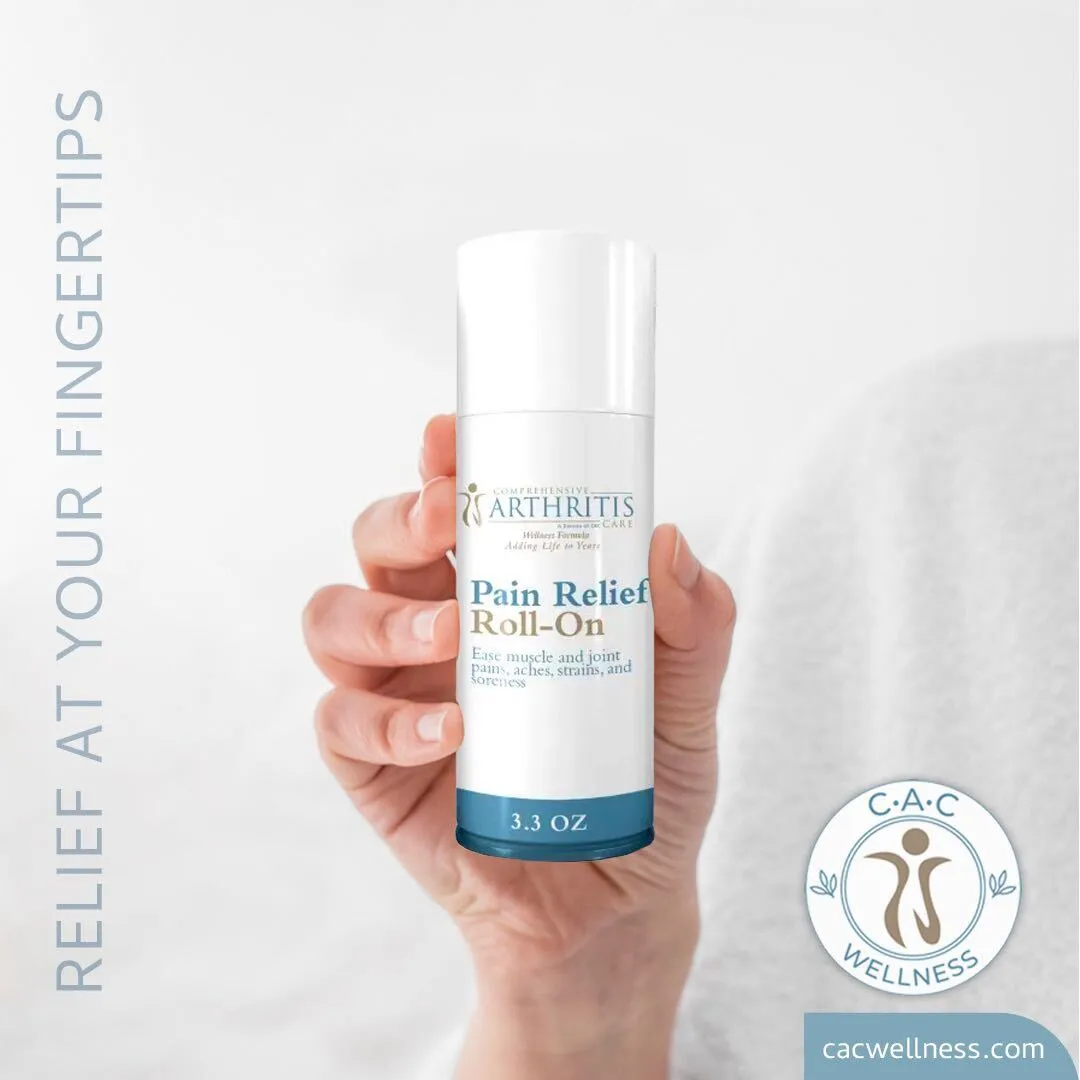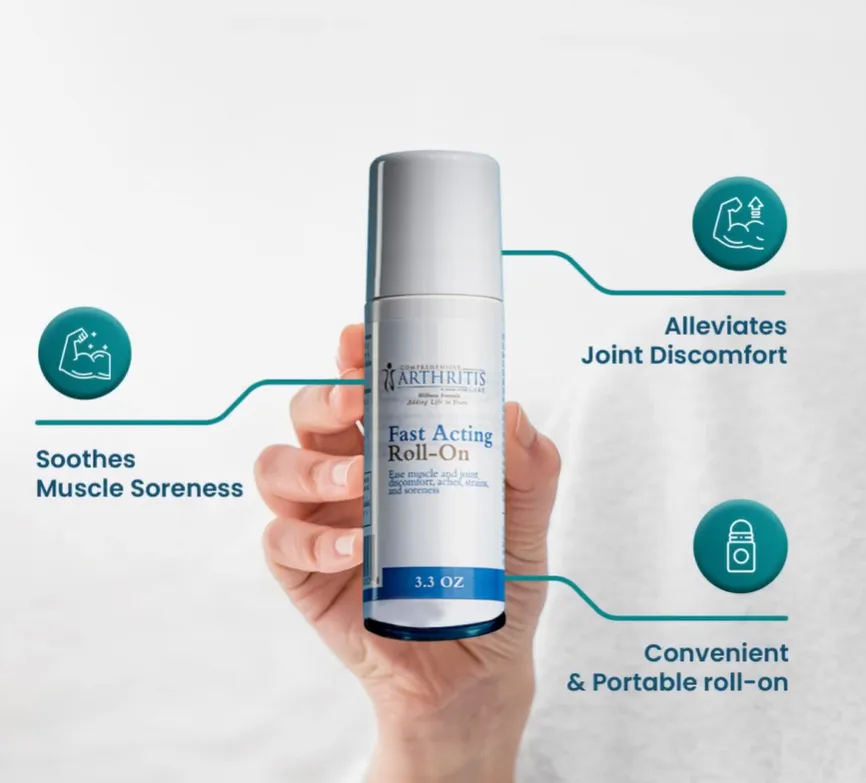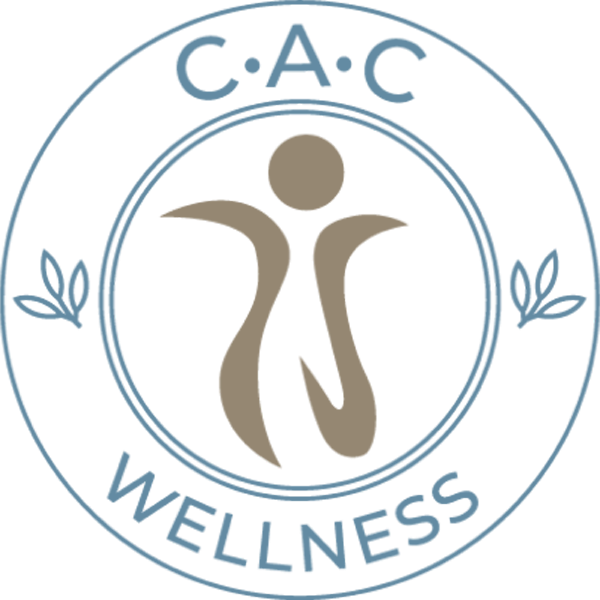How do Topical Pain Relief Roll-ons Work?
Topical pain relief roll on by CAC Wellness delivers targeted relief through skin absorption. It contains ingredients like capsaicin & menthol to alleviate pain & inflammation.

Dealing with chronic pain can often make you feel alone in your struggles.
If you haven't experienced it firsthand, it's difficult to truly understand the immense impact it can have on both your body & mind. While others might notice your outward discomfort, they may not comprehend the constant internal battle you face every day.
If you're someone who lives with chronic pain, you're probably familiar with the various methods used to manage joint pains & inflammation.
Among these methods, topical pain relief solutions such as creams, gels, and pain relief roll on are tried & tested over the counter (OTC) treatments.
Yet, despite the availability of these remedies, finding effective relief can still feel like an ongoing challenge.
Amidst this journey, it's crucial to seek support and guidance from healthcare professionals who can help tailor a treatment plan to your specific needs.
So, if you're living with chronic pain, know that you're not alone. There are options available to help manage your symptoms and improve your quality of life.
Treatments absorbed through your skin
Topical pain relief medications such as gels, cream, or pain relief roll on penetrate the skin, offering targeted relief to areas of pain or discomfort.
Creams, gels, and patches are the most prevalent forms of topical treatments. Simply apply them to the skin over the affected joints, particularly effective for joints that are close to the skin like those in the hands and knees.
For instance, C.A.C Wellness pain relief roll on utilizes capsaicin, which triggers the burning sensation associated with chili peppers. It also incorporates counterirritants like menthol, inducing hot & cold sensations on the skin.
Capsaicin1 functions by obstructing a chemical in nerve cells responsible for transmitting pain signals. However, it's crucial to recognize that capsaicin-based products may necessitate up to two weeks of regular use before significant relief is experienced.
Apart from capsaicin-based products, other non-prescription topical treatments include the following.
- Salicylates: Containing the same pain-relieving component as aspirin.
- Anesthetics: Topical anesthetics such as lidocaine induced numbness, diminishing pain sensations.
Analgesic creams, rubs, and sprays
Topical painkillers, known as analgesics, are applied to the skin over sore muscles or joints through spraying, rubbing, or patches or as pain relief roll-ons. While all aim to relieve pain, they comprise different ingredients. Here are some common types.
- Counterirritants, including menthol, methyl salicylate (derived from evergreen oil), and camphor. They produce a burning or cooling sensation that diverts attention from the pain.
- Salicylates, also found in aspirin2, are present in certain creams and can alleviate pain, particularly in joints close to the skin like fingers, knees3, and elbows
- Prescription NSAIDs in topical forms have reduced typical NSAID side effects like stomach issues and bleeding, but should not be used alongside oral NSAIDs.
- Capsaicin4, derived from hot chili peppers, is highly effective for topical pain relief, especially for joint and diabetic nerve pain. Initially, capsaicin creams may cause warmth or burning, which diminishes over time. Relief may take a few days to weeks to show.
- Lidocaine, a numbing agent, is available as a gel or patch for application to painful areas. Consult your doctor if you have liver problems or take heart rhythm drugs before use.
For optimal effects & risk reduction, make sure you do the following.
- Carefully read and adhere to package instructions.
- Avoid applying to wounds or damaged skin.
- Do not combine with a heating pad to prevent burns.
- Refrain from using them under tight bandages.
- After use, thoroughly wash your hands or wear gloves to prevent contact with eyes.
- If allergic to aspirin or taking blood thinners5, consult your doctor before using topical medications containing salicylates.
How to use topical pain relief?
Let’s move on to how you should use6 topical pain-relief medication and pain relief roll-ons.
Before using this OTC product, thoroughly review and adhere to all instructions provided on the product packaging. If any uncertainties arise, consult your pharmacist. If your physician has prescribed this medication, use it as directed.
This medication is intended solely for topical application. Apply it to the affected area no more than 3 to 4 times daily. When using creams, gels, or liquids, ensure you rub it in gently but thoroughly.
Some liquid formulations may require shaking before use; refer to the manufacturer's instructions for specific guidance. Allow the medication to completely dry before permitting contact with the treated area.
After application, wash your hands thoroughly. Avoid contact with the eyes, nose, or mouth. If accidental exposure occurs in these areas, promptly rinse with water.
Avoid applying the medication to severe burns or deep wounds, and refrain from tightly wrapping or bandaging the affected area, as this may heighten the risk of side effects.
While loosely covering the area to protect clothing is permissible, avoid overheating, as it can worsen side effects. Refrain from applying the medication immediately before, during, or after activities that increase skin temperature, such as bathing, swimming, or exercise.
Additionally, avoid using sunlamps, tanning beds, hot water bottles, or heating pads/devices on the treated area.
Even if previously familiar with the product, review the ingredient list, as formulations may change. Read the label attentively to make sure you’re selecting the appropriate product for your condition. If you’re still unsure, consult your pharmacist.
Should your condition persist for more than 7 days, worsen, or recur, inform your physician. Additionally, if you suspect a serious medical issue, seek prompt medical attention.
Hot & cold packs
Hot or cold therapy, either individually or in combination, presents a viable option for alleviating discomfort in sore muscles and joints.
Cold therapy
Cold application numbs sore areas and is particularly beneficial for managing pain and swelling during an arthritis flare-up or following a joint injury like a sprained ankle. Cold may mitigate inflammation by constricting blood flow to the affected area.
Cold can be applied using various methods, including:
- Commercial cold packs
- Water bottles filled with ice and cold water
- Storage bags filled with ice and water
- Towel dipped into cold water and ice
Heat therapy
Heat application aids in muscle relaxation by dilating blood vessels7, thereby increasing oxygen and blood flow to the region and reducing pain sensation.
Methods for applying heat include the following.
- Commercial heat packs
- Heating pads
- Hot water bottles
- Soaking in a hot bathtub
- Standing under a hot shower
- Applying a warm washcloth or hand towel to painful joints or muscles
Tips for safe & effective use
- Limit heat or cold application to 15-20 minutes per session.
- Place a towel between the skin and the hot or cold source to prevent skin damage.
- Avoid using heat or cold on skin with open cuts or sores.
- If you have vasculitis or poor circulation, refrain from using cold packs.
- Always test the temperature before applying heat or cold to avoid burns or discomfort.
- Refrain from using creams, heat rubs, or lotions while undergoing hot or cold treatment.
- Exercise caution with heating pads to prevent burns from excessive heat or prolonged use.
Is topical pain relief safe & effective?
The safety and efficacy8 of topical pain relief products vary among individuals.
- Many people find relief from arthritis pain using these products, but scientific research doesn't always conclusively support their effectiveness.
- While some alternative products may provide marginal benefits, they often perform similarly to placebos in clinical studies.
- Combining capsaicin-based products with oral nonsteroidal anti-inflammatory drugs may enhance their effectiveness.
- However, it's essential to consider safety when using these products.
- With capsaicin creams, you may experience burning or stinging sensations, especially during the initial weeks of daily use.
- Thoroughly wash your hands after each application and avoid touching your eyes. Consider wearing latex gloves during application.
- Refrain from using topical pain relievers on broken or irritated skin and avoid using them with heating pads or bandages to prevent adverse reactions.
- If you're allergic to aspirin or taking blood thinners, consult your healthcare provider before using topical medicines containing salicylates.
Side effects
Redness, warmth, or irritation may occur at the site of application. Should these side effects9 persist or worsen, inform your doctor or pharmacist.
If your physician has instructed you to use this medication, it is because they have determined that the benefits outweigh the risks of side effects. Most individuals using this medication do not experience severe side effects.
Discontinue use and notify your doctor immediately if you experience any serious side effects, such as blistering or swelling at the application site, or increased/unusual pain at the site.
Although rare, a severe allergic reaction to this drug can occur. Seek medical assistance immediately if you observe symptoms such as rash, itching/swelling (particularly of the face/tongue/throat), severe dizziness, or difficulty breathing.
This list does not encompass all potential side effects. Should you notice any other effects not mentioned here, contact your doctor or pharmacist.
Precautions
Before using this pain relief medication or roll-ons, you should inform your doctor or pharmacist of any allergies you may have, particularly to menthol, or any other allergens. This product may contain inactive ingredients that could potentially trigger allergic reactions or other side effects.
Before starting any kind of topical pain relief, disclose your medical history to your healthcare provider or pharmacist.
Additionally, before undergoing any surgical procedure, ensure that your doctor or dentist is aware of all medications you are currently using, including prescription drugs, over-the-counter drugs, and herbal products.
During pregnancy, the use of this medication should only be considered if it is deemed necessary after consulting with your healthcare provider or gynecologist.
Whether this medication seeps into breast milk is uncertain. Therefore, it is advisable to seek advice from your doctor before breastfeeding.
C.A.C Pain Relief Roll-on
C.A.C Wellness provides a safe and effective pain relief roll-on that brings comforting coolness and quick pain relief.
Its formula includes carefully chosen ingredients like MCT oil, peppermint oil, and menthol, all aimed at soothing pain and reducing swelling.
Additional ingredients such as jojoba oil and shea butter intensify its soothing effects. This roll-on offers a soothing experience that contributes to overall wellness.
Products like C.A.C Wellness roll-on, which uses capsaicin, can help manage joint pain and inflammation.
While results may differ, these topical treatments offer targeted relief with fewer risks of side effects compared to pills. It's important to consult a healthcare professional before starting any pain relief routine.

References:
1. Mayo Clinic Staff. (n.d.). Pain medications: How well do topical products work? Retrieved March 6, 2024, from Mayo Clinic website: https://www.mayoclinic.org/diseases-conditions/osteoarthritis/in-depth/pain-medications/art-20045899
2. WebMD. (n.d.). Aspirin extended-release capsule oral: Uses, side effects, interactions, pictures, warnings & dosing. Retrieved March 6, 2024, from WebMD website: https://www.webmd.com/drugs/2/drug-1082-1727/aspirin-oral/aspirin-extended-release-capsule-oral/details
3. WebMD. (2023, May 14). Knee pain overview: Symptoms, causes, diagnosis, treatment, and prevention. Retrieved March 6, 2024, from WebMD website: https://www.webmd.com/pain-management/knee-pain/knee-pain-overview
4. WebMD. (n.d.). Capsaicin topical: Uses, side effects, interactions, pictures, warnings & dosing. Retrieved March 6, 2024, from WebMD website: https://www.webmd.com/drugs/2/drug-4181/capsaicin-topical/details
5. WebMD. (2023, August 22). Slideshow: Tips for taking blood thinners. Retrieved March 6, 2024, from WebMD website: https://www.webmd.com/heart-disease/ss/slideshow-tips-for-taking-blood-thinners
6. WebMD. (n.d.). Menthol topical gel: Uses, side effects, interactions, pictures, warnings & dosing. Retrieved March 6, 2024, from WebMD website: https://www.webmd.com/drugs/2/drug-61777-2101/pain-relief-gel-topical/menthol-topical/details
7. WebMD. (2023, February 22). Quiz: Blood basics. Retrieved March 6, 2024, from WebMD website: https://www.webmd.com/a-to-z-guides/cm/rm-quiz-blood-basics
8. CAC Wellness. (2024, February 12). How effective are pain relief roll on for joint pains & inflammation? Retrieved March 6, 2024, from CAC Wellness website: https://cacwellness.com/blog/2024/02/12/how-effective-are-pain-relief-roll-ons-for-joint-pains-inflammation/
9. WebMD. (n.d.). Menthol topical gel: Uses, side effects, interactions, pictures, warnings & dosing. Retrieved March 6, 2024, from WebMD website: https://www.webmd.com/drugs/2/drug-61777-2101/pain-relief-gel-topical/menthol-topical/details


